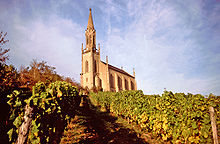Nahe (wine-growing region)
The Nahe wine-growing region is a German wine-growing region in accordance with Section 3 (1) No. 7 of the Wine Act . It is located in Rhineland-Palatinate in the area of the left Rhine tributary Nahe and its tributaries Glan and Alsenz , where wine has been grown since Roman times . Mainly the grape varieties Riesling (share 27.3%), Müller-Thurgau (13.4%), Dornfelder (10.8%) and Silvaner (6.5%) are cultivated on around 4,063 hectares (as of 2012) . 75% white wine is produced , 25% red wine .
The approximately 97 km long Rhine-Nahe Wine Trail leads from Kirn an der Nahe to Bingen am Rhein through the Soonwald-Nahe Nature Park and opens up the entire wine-growing region of the Middle and Lower Nahe for hikers.
The Nahe Wine Road runs through the wine-growing region . For the area wine queen, see Nahe Wine Queen .
Geographical location

The Nahe wine-growing region, which has only been run as an independent wine-growing region in Rhineland-Palatinate since 1971 , extends from the mouth of the Nahe upstream to shortly before Kirn and into the side valleys of Guldenbach , Graefenbach , Glan and Alsenz. To the north-west it is protected by the Hunsrück , to the north by the Taunus , and to the south-east is the North Palatinate Uplands . The economic center of the wine-growing region is the spa town of Bad Kreuznach .
Floors
The Nahe wine-growing region has the greatest variety of soils and the narrowest berths in Germany. More than 180 soil variants were suspected and examined in the stone and wine project . The results were published in 2013 by the Rhineland-Palatinate Ministry for Economic Affairs, Climate Protection, Energy and State Planning. Due to this geological diversity, the area occupies a special position: Quartz and slate soils can be found on the lower Nahe , porphyry , melaphyre and red sandstone on the middle Nahe. Around Bad Kreuznach there are weathered soils and clay layers made of sandstone, loess and loam . The vineyards are mostly on flat and hilly locations. Only a small part, mainly in the area around Bad Münster am Stein , are steep slopes .
Especially the Riesling produces very mineral, elegant wines.
Grape varieties
76% of the vineyards are planted with white grape varieties.
Riesling (29%) and Müller-Thurgau (approx. 12%) dominate the range of white wines . Furthermore, Dornfelder (9.7%), Silvaner (4.9%), Pinot Noir ( 6.7%), Pinot Blanc (7.4%) and Pinot Gris (8.2%) are grown to a significant extent .
|
|||||||||||||||||||||||||||||||||||||||||||||||||||||||||||||||||||||||||||||||||||||
White varieties
|
||||||
|---|---|---|---|---|---|---|
Red varieties
|
||||||
|---|---|---|---|---|---|---|
Breakdown
Until 1993 there were still two areas: the Kreuznach area and the Schlossböckelheim area. Today, the Nahe wine-growing region is divided into an area with six large sites and around 313 individual sites and comprises around 4,000 hectares of vineyards.
Nahetal area
Large layers:
- Castle chapel with the villages: Münster-Sarmsheim , Guldental , Laubenheim , Layen Castle , Windesheim , Schweppenhausen and Dorsheim
- Sonnenborn with the village of Langenlonsheim
- Parish garden with the villages of Wallhausen , Spabrücken , Dalberg , Hergenfeld , Sommerloch and Gutenberg / St. Ruppertsberg
- Kronenberg with the city of Bad Kreuznach and the villages of Bretzenheim and Hargesheim
- Rose garden with the villages of Mandel , Roxheim , Rüdesheim and Weinsheim
- Paradise garden with the villages Waldböckelheim , Meddersheim , Kirschroth , Monzingen , Weiler u. a.
- Burgweg with the villages of Niederhausen , Oberhausen , Norheim , Schlossböckelheim , Altenbamberg , Ebernburg , Traisen and Duchroth
Viticulture on Glan and Alsenz
Although the vineyards on Glan and Alsenz are predominantly on Palatinate soil, they belong to the Nahe wine-growing region. There are also places with a long winemaking tradition here.
On the Glan
On the Alsenz
literature
- Dieter Braatz, Ulrich Sauter, Ingo Swoboda, Hendrik Holler: Wine Atlas Germany . 1st edition. Hallwag, Munich 2007, ISBN 978-3-8338-0638-4 .
- Stuart Pigott , Andreas Durst, Ursula Heinzelmann , Chandra Kurt , Manfred Lüer, Stephan Reinhardt: Wine speaks German . 1st edition. Scherz, Frankfurt am Main 2007, ISBN 978-3-502-19000-4 .
- Jancis Robinson : The Oxford Wine Lexicon . Hallwag, Gräfe and Unzer, Munich 2006, ISBN 978-3-8338-0691-9 .
- André Dominé (Ed.): Wine . Könemann, Cologne 2000, ISBN 3-8290-2765-6 .
Web links
Individual evidence
- ↑ Statistics 2013/2014 ( Memento from July 8, 2014 in the Internet Archive ) (PDF; 723 kB). Website of the German Wine Institute. Retrieved November 6, p. 14
- ^ Project Stone and Wine ( Memento from December 22, 2013 in the Internet Archive )
- ^ Vineyard soils in Rhineland-Palatinate. (PDF) stones. Floors. Terroir. Ministry for Economic Affairs, Climate Protection, Energy and State Planning Rhineland-Palatinate, 2013, accessed on April 14, 2020 .
- ↑ German Wine Institute : Statistics 2009/2010; Federal Office of Statistics
- ↑ State Statistical Office of Rhineland-Palatinate: Planted vineyards for wine grapes 1989–2009 according to selected grape varieties and growing areas . Mainz 2009.
- ↑ a b Taschenbuch der Weinsorten , Fachverlag Fraund
- ^ German wine. Statistics 2013/2014 ( Memento from July 8, 2014 in the Internet Archive ) (PDF; 723 kB). Website of the German Wine Institute. Retrieved November 6, 2013, p. 14.
- ↑ Further information on the Nahe wine region. ( Memento of November 17, 2013 in the Internet Archive ). Rhineland-Palatinate Tourism website. Retrieved November 6, 2013.

